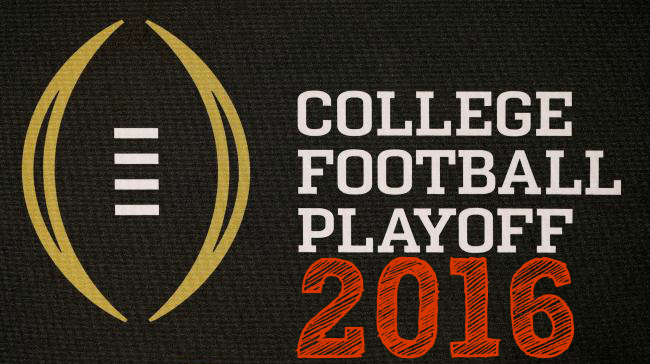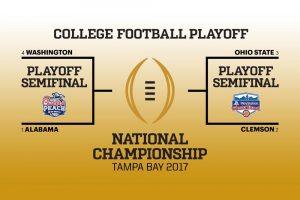
The College Football Playoff committee selected Alabama, Ohio State, Clemson and Washington, expectedly choosing the only four Power 5 conference teams without multiple losses and leaving out surging Penn State despite the Nittany Lions’ victory in Saturday night’s Big Ten championship.
In the semifinals on Dec. 31, No. 1 Alabama will play No. 4 Washington in Atlanta and No. 2 Clemson will play No. 3 Ohio State in Glendale, Arizona. The winners will play Jan. 9 for the national title in Tampa.
The committee made no significant changes to the top four of its penultimate rankings after three members of the incumbent foursome prevailed in conference title games this weekend and the fourth, Ohio State, sat idle. As a result, the Buckeyes dropped one slot to No. 3, while the Tigers rose to No. 2, but those two teams will still meet in the semis.
Penn State gave the committee something to ponder late Saturday night, when it erased a 28-7 deficit to topple then-No. 6 Wisconsin, 38-31, in the Big Ten title game. The Nittany Lions won the Big Ten, regarded this season as the nation’s toughest league, and finished its season with a nine-game winning streak, which included a victory over Ohio State in October.
“We just won the toughest conference in college football!” Penn State Coach James Franklin hollered on the field in Indianapolis, surrounded by screaming fans and confetti. “It’s on you now, the committee.”
But the Buckeyes became the first team not to win its conference, nor its division, to make the College Football Playoff. Committee chairman Kirby Hocutt said the committee arrived at the Buckeyes through statistical analysis, both in regard to the strength of schedules and on-field performance. Penn State finished No. 5, in front of Michigan at No. 6 and a sliver away from a shot at the title.
“Conference championships are hard to win, and we saw some great games yesterday,” Hocutt said. “As a selection committee, we come back to our charge, our mission. And that is to select the four very best teams in college football.”
It was a victory, then, for both Ohio State and fans who prefer audacious September schedules and a nuanced approach to picking top teams.
Back in the season’s third week, Ohio State clobbered eventual Big 12 champion and 11-2 finisher Oklahoma, 45-24, in Norman. The victory buoyed the Buckeyes’ resume all season and may have provided the ultimate edge over the Nittany Lions. Ohio State also suffered one fewer loss and defeated powerful Michigan, which annihilated Penn State, 49-10, before Penn State ran off nine victories in a row.
Beyond the simple fact it had two losses compared to one for other contenders, Penn State’s exclusion could be seen as a referendum on the imprecise meaning of league championships in an era of bloated conferences. Between 2010 and 2014, the Big Ten swelled from 11 teams to 14, including the addition of Maryland, following the model other leagues used to expand their reach into more television markets, with the aim of negotiating more lucrative rights deals.
The ballooning of the Big Ten created two seven-team divisions and ensured teams would not face four of their conference foes each season, adding a tinge of arbitrariness to the crowing of a champion. This season, it meant Wisconsin advanced to the title game as winner of the West division despite losing to East powers Michigan and Ohio State, while Penn State advanced on a tiebreaker by virtue of its victory over Ohio State despite getting blown out against Michigan.
Through the machinations of unbalanced schedules and divisional tiebreakers, the Big Ten staged a title game between teams considered by popular consensus to be the league’s third- and fourth-best. In winning the Big Ten, Penn State could celebrate an achievement unto itself. On a national scale, though, the committee did not judge the title to mean Penn State was the best team in the Big Ten.
“You can make arguments for and against so many different teams,” Franklin said on ESPN’s selection show. “Us being Big Ten champions and winning a game head-to-head we felt like gave us a lot of value, and the fact we’re hot right now. You could make arguments a lot of different ways.”
If they wanted a bone to pick, Penn State and even Michigan could focus on the weakness of UW’s nonconference schedule. The Huskies barbecued Rutgers, Idaho and Portland State to begin the season, giving them an out-of-conference slate ranked 127th-hardest out of 128 FBS teams. But Washington shredded through its Pac-12 schedule with only one loss, to Southern California, and concluded with a resounding, 41-10 shellacking of then-No. 8 Colorado in the championship.
“Had Washington had a stronger strength of schedule,” Hocutt said, “I don’t think the conversation would have been as difficult.”
Clemson specialized in wobbly victories all season, right up until Saturday night’s 42-35 survival of Virginia Tech, which advanced to Clemson’s 24-yard line in the final two minutes. But the defending national runner up did enough to counter its lone loss, against Pittsburgh, to advance with little question.
Alabama had an unimpeachable case. The defending national champions are the best team in the country by any reasonable measure. They pasted Florida, 54-16, in Saturday’s SEC title game to move to 13-0 and remain the only unbeaten in the Power 5.
Western Michigan, the plucky champion of the MAC, is also 13-0 and will have a date in the Cotton Bowl.
(c) 2016, The Washington Post · Adam Kilgore
Image: FBSchedules


